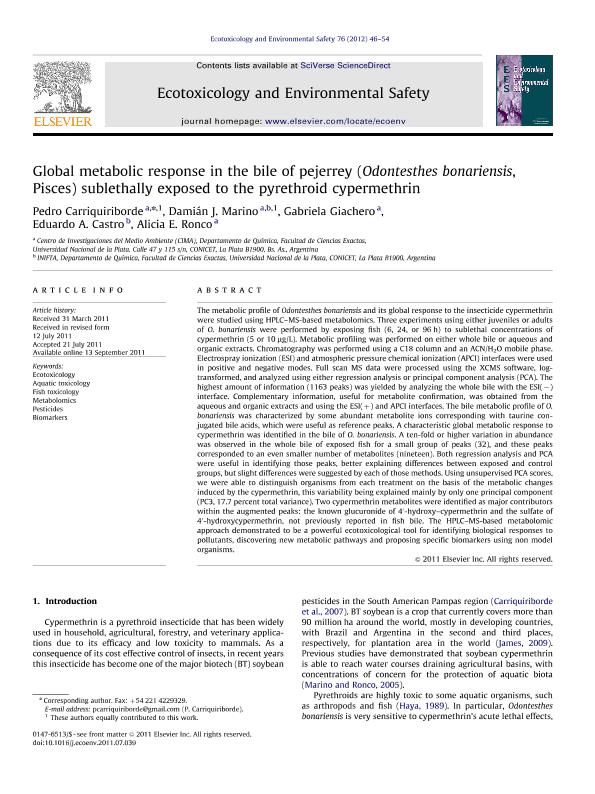Artículo
Global metabolic response in the bile of pejerrey (Odontesthes bonariensis, Pisces) sublethally exposed to the pyrethroid cypermethrin
Carriquiriborde, Pedro ; Marino, Damian Jose Gabriel
; Marino, Damian Jose Gabriel ; Giachero; Castro, Eduardo Alberto
; Giachero; Castro, Eduardo Alberto ; Ronco, Alicia Estela
; Ronco, Alicia Estela
 ; Marino, Damian Jose Gabriel
; Marino, Damian Jose Gabriel ; Giachero; Castro, Eduardo Alberto
; Giachero; Castro, Eduardo Alberto ; Ronco, Alicia Estela
; Ronco, Alicia Estela
Fecha de publicación:
02/2012
Editorial:
Academic Press Inc Elsevier Science
Revista:
Ecotoxicology and Environmental Safety
ISSN:
0147-6513
Idioma:
Inglés
Tipo de recurso:
Artículo publicado
Clasificación temática:
Resumen
The metabolic profile of Odontesthes bonariensis and its global response to the insecticide cypermethrin were studied using HPLC-MS-based metabolomics. Three experiments using either juveniles or adults of O. bonariensis were performed by exposing fish (6, 24, or 96h) to sublethal concentrations of cypermethrin (5 or 10μg/L). Metabolic profiling was performed on either whole bile or aqueous and organic extracts. Chromatography was performed using a C18 column and an ACN/H2O mobile phase. Electrospray ionization (ESI) and atmospheric pressure chemical ionization (APCI) interfaces were used in positive and negative modes. Full scan MS data were processed using the XCMS software, log-transformed, and analyzed using either regression analysis or principal component analysis (PCA). The highest amount of information (1163 peaks) was yielded by analyzing the whole bile with the ESI(-) interface. Complementary information, useful for metabolite confirmation, was obtained from the aqueous and organic extracts and using the ESI(+) and APCI interfaces. The bile metabolic profile of O. bonariensis was characterized by some abundant metabolite ions corresponding with taurine conjugated bile acids, which were useful as reference peaks. A characteristic global metabolic response to cypermethrin was identified in the bile of O. bonariensis. A ten-fold or higher variation in abundance was observed in the whole bile of exposed fish for a small group of peaks (32), and these peaks corresponded to an even smaller number of metabolites (nineteen). Both regression analysis and PCA were useful in identifying those peaks, better explaining differences between exposed and control groups, but slight differences were suggested by each of those methods. Using unsupervised PCA scores, we were able to distinguish organisms from each treatment on the basis of the metabolic changes induced by the cypermethrin, this variability being explained mainly by only one principal component (PC3, 17.7 percent total variance). Two cypermethrin metabolites were identified as major contributors within the augmented peaks: the known glucuronide of 4'-hydroxy-cypermethrin and the sulfate of 4'-hydroxycypermethrin, not previously reported in fish bile. The HPLC-MS-based metabolomic approach demonstrated to be a powerful ecotoxicological tool for identifying biological responses to pollutants, discovering new metabolic pathways and proposing specific biomarkers using non model organisms.
Archivos asociados
Licencia
Identificadores
Colecciones
Articulos(INIFTA)
Articulos de INST.DE INV.FISICOQUIMICAS TEORICAS Y APLIC.
Articulos de INST.DE INV.FISICOQUIMICAS TEORICAS Y APLIC.
Citación
Carriquiriborde, Pedro; Marino, Damian Jose Gabriel; Giachero; Castro, Eduardo Alberto; Ronco, Alicia Estela; Global metabolic response in the bile of pejerrey (Odontesthes bonariensis, Pisces) sublethally exposed to the pyrethroid cypermethrin; Academic Press Inc Elsevier Science; Ecotoxicology and Environmental Safety; 76; 1; 2-2012; 46-54
Compartir
Altmétricas



